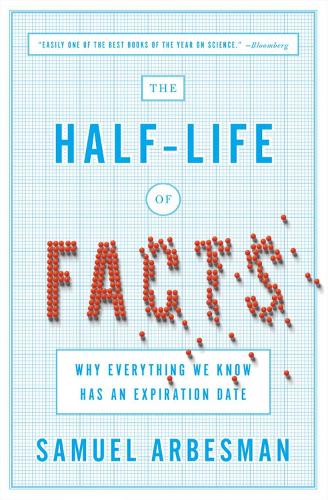
The Half Life Of Facts: Why Everything We Know Has An Expiration Date
(Paperback)
Publishing Details
The Half Life Of Facts: Why Everything We Know Has An Expiration Date
By (Author) Samuel Arbesman
Penguin Putnam Inc
Current
2nd January 2014
United States
Classifications
General
Non Fiction
Applied mathematics
Probability and statistics
Popular science
501
Physical Properties
Paperback
256
Width 138mm, Height 214mm
228g
Description
Facts change all the time and what is known about the world is constantly in flux. There is an order to the state of knowledge, an explanation for how facts are formed. Samuel Arbesman is an expert in the field of scientometrics, literally the science of science. In this book, Arbesman encompasses a wide variety of fields and speeds of change all illustrated with intriguing examples. The Half-Life of Facts is a riveting journey into the counterintuitive fabric of knowledge, offering a new way to measure the world and showing the limits of how much can be known with certainty.
Reviews
The Half-Life of Facts is easily one of the best books of the year on science.
Bloomberg
Delightfully nerdy.
The Wall Street Journal
"Absorbing and approachable treatise on the nature of facts: what they are, how and why they change and how they sometimes dont (despite being wrong)Facts matter. But when they changeas they seem today to do with alarming frequency, we begin to lose that control. In his debut, Arbesmanadvises us not to worry: While we cant stop facts from changing, we can recognize that what we know changes in understandable and systematic ways. With this, he introducesscientometrics, the science of science. With scientometrics, we can measure the exponential growth of facts, how long it will take, exponentially, for knowledge in any field to be disprovedsay, 45 years for medical knowledgelike a good college professor, Arbesmans enthusiasm and humor maintains our interest in subjects many readers may not have encountered before[The Half-Life of Facts] does what popular science should doboth engages and entertains."
Kirkus Reviews
How many chromosomes do we have How high is Mount Everest Is spinach as good for you as Popeye thoughtand what scientific blunder led him to think so in the first placeThe Half-life of Factsis fun and fascinating, filled with wide-ranging stories and subtle insights about how facts are born, dance their dance, and die. In todays world, where knowledge often changes faster than we do, Samuel Arbesmans new book is essential reading.
Steven Strogatz, professor of mathematics, Cornell University, and author ofThe Joy of X
What does it mean to live in a world drowning in facts ConsiderThe Half-life of Factsthe new go-to book on the evolution of science and technology.
Tyler Cowen, professor of economics, George Mason University, and author ofAn Economist Gets Lunch
The Half-life of Factsis a rollicking intellectual journey. Samuel Arbesman shares his extensive knowledge with infectious enthusiasm and entertaining prose. Even if the facts around us are ever changing, the lessons and fun in this book will have a very long half-life!
Michael J. Mauboussin, chief investment strategist, Legg Mason Capital Management, and author ofThe Success Equation
The Half-life of Factsteaches you that it is possible, in fact, to drink from a firehose. Samuel Arbesman, an extremely creative scientist and storyteller, explores the paradox that knowledge is tentative in particularly consistent ways. In his capable hands, we learn about everything from how medieval manuscripts resemble genetic code to what bacteria and computer chips have in common. This book unravels the mystery of how we come to know the truthand how long we can be certain about it.
Nicholas A. Christakis, MD, PhD, coauthor of Connected
"Facts fall apart, some famously so. Brontosaurus is not a real dinosaur species; Pluto is not a planet. When you look at them en masse, patterns emerge: Facts die, and are born, at specific, predictable rates. These rates are the subject of applied mathematician Samuel Arbesmans engaging, insightful jaunt across the backstage of scientific knowledge. Packed with interesting tidbitsfor instance, more than a third of mammals thought to have gone extinct in the last 500 years have since reappearedthe book explains how facts spread and change over time. It also explores how todays data-soaked reality has yielded high-throughput, automated ways to produce new truths, like algorithms that discover connections between genes and disease."
Veronique Greenwood,Discovermagazine
"Knowledge shifts over time, explains Sam Arbesman inThe Half-Life of Facts, and it does so in predictable ways. The book takes us on a whirlwind tour of emerging fields of scientometrics, and undertakes a broader exploration of metaknowledge. Arbesman details how researchers beginning to focus the big-data lens back on science itself are uncovering quantitative laws and regularities in the way that scientific knowledge is constructed and modified over time.Arbesman is a delightful guide to the territory, patently in love with this emerging field. He is also a skilled storyteller, and his wide-eyed reporting invigorates material that could have been dry and academic."
Carl Bergstrom,Naturemagazine
Author Bio
Samuel Arbesman is an applied mathematician and network scientist. He is a Senior Scholar at the Ewing Marion Kauffman Foundation and a fellow at the Institute for Quantitative Social Science at Harvard University. His writing has appeared in the New York Times, the Atlantic, Wired, New Scientist and the Boston Globe. He lives in Kansas City. Visit www.arbesman.net
